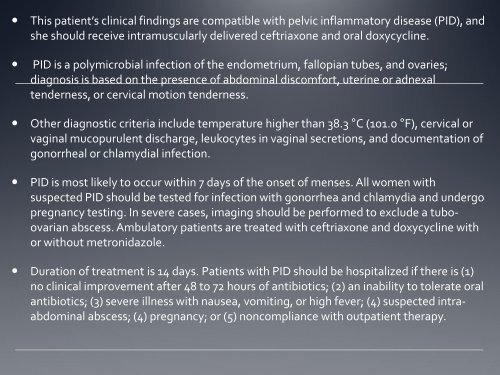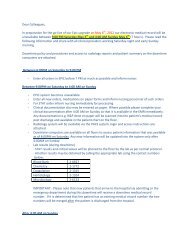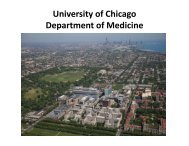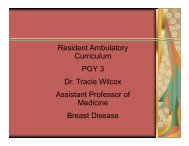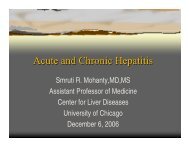Pott's disease in pregnancy - The University of Chicago Department ...
Pott's disease in pregnancy - The University of Chicago Department ...
Pott's disease in pregnancy - The University of Chicago Department ...
Create successful ePaper yourself
Turn your PDF publications into a flip-book with our unique Google optimized e-Paper software.
This patient’s cl<strong>in</strong>ical f<strong>in</strong>d<strong>in</strong>gs are compatible with pelvic <strong>in</strong>flammatory <strong>disease</strong> (PID), and<br />
she should receive <strong>in</strong>tramuscularly delivered ceftriaxone and oral doxycycl<strong>in</strong>e.<br />
PID is a polymicrobial <strong>in</strong>fection <strong>of</strong> the endometrium, fallopian tubes, and ovaries;<br />
diagnosis is based on the presence <strong>of</strong> abdom<strong>in</strong>al discomfort, uter<strong>in</strong>e or adnexal<br />
tenderness, or cervical motion tenderness.<br />
Other diagnostic criteria <strong>in</strong>clude temperature higher than 38.3 °C (101.0 °F), cervical or<br />
vag<strong>in</strong>al mucopurulent discharge, leukocytes <strong>in</strong> vag<strong>in</strong>al secretions, and documentation <strong>of</strong><br />
gonorrheal or chlamydial <strong>in</strong>fection.<br />
PID is most likely to occur with<strong>in</strong> 7 days <strong>of</strong> the onset <strong>of</strong> menses. All women with<br />
suspected PID should be tested for <strong>in</strong>fection with gonorrhea and chlamydia and undergo<br />
<strong>pregnancy</strong> test<strong>in</strong>g. In severe cases, imag<strong>in</strong>g should be performed to exclude a tuboovarian<br />
abscess. Ambulatory patients are treated with ceftriaxone and doxycycl<strong>in</strong>e with<br />
or without metronidazole.<br />
Duration <strong>of</strong> treatment is 14 days. Patients with PID should be hospitalized if there is (1)<br />
no cl<strong>in</strong>ical improvement after 48 to 72 hours <strong>of</strong> antibiotics; (2) an <strong>in</strong>ability to tolerate oral<br />
antibiotics; (3) severe illness with nausea, vomit<strong>in</strong>g, or high fever; (4) suspected <strong>in</strong>traabdom<strong>in</strong>al<br />
abscess; (4) <strong>pregnancy</strong>; or (5) noncompliance with outpatient therapy.


